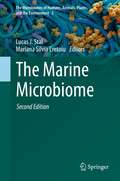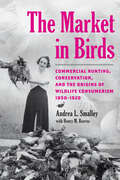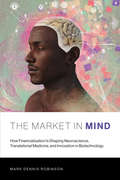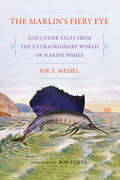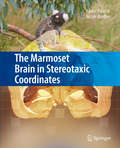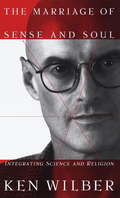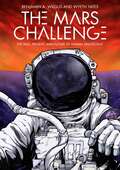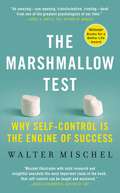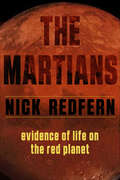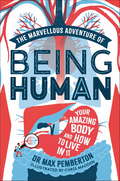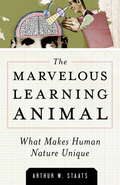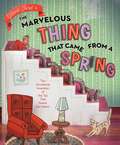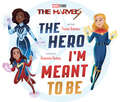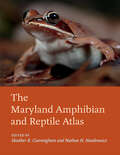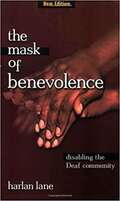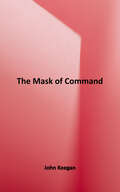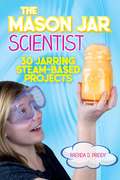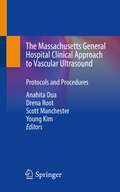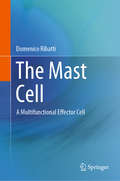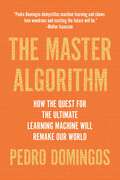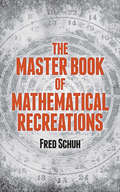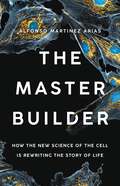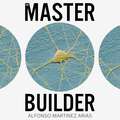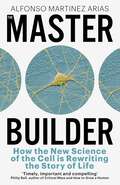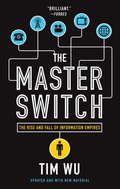- Table View
- List View
The Marine Microbiome (The Microbiomes of Humans, Animals, Plants, and the Environment #3)
by Lucas J. Stal Mariana Silvia CretoiuThis updated and expanded second edition reviews numerous aspects of the marine microbiome and its possible industrial applications. The marine microbiome is the total of microorganisms and viruses in the ocean and seas and in any connected environment, including the seafloor and marine animals and plants. In the first part of the book, diversity, origin and evolution of the marine microorganisms and viruses are discussed. The microbes presented originate from all three domains of life: Bacteria, Archaea, and Eukarya. The second part sheds some light on the different communities: it describes marine habitats and how their inhabitants control biogeochemical cycles. The third part finally examines the microbial ocean as a global system and evaluates methods of utilizing marine microbial resources. Adopting a translational approach, the book connects academic research with industrial applications, making it a fascinating read and valuable resource for microbiologists from both domains.
The Market in Birds: Commercial Hunting, Conservation, and the Origins of Wildlife Consumerism, 1850–1920
by Andrea L. SmalleyA fascinating look at how a commercial market for birds in the late nineteenth century set the stage for conservation and its legislation.Between the end of the Civil War and the 1920s, the United States witnessed the creation, rapid expansion, and then disappearance of a commercial market for hunted wild animals. The bulk of commercial wildlife sales in the last part of the nineteenth century were of wildfowl, who were prized not only for their eggs and meat but also for their beautiful feathers. Wild birds were brought to cities in those years to be sold as food for customers' tables, decorations for ladies' hats, treasured pets, and specimens for collectors' cabinets. Though relatively short-lived, this market in birds was broadly influential, its rise and fall coinciding with the birth of the Progressive Era conservation movement. In The Market in Birds, historian Andrea L. Smalley and wildlife biologist Henry M. Reeves illuminate this crucial chapter in American environmental history. Touching on ecology, economics, law, and culture, the authors reveal how commercial hunting set the terms for wildlife conservation and the first federal wildlife legislation at the turn of the twentieth century. Smalley and Reeves delve into the ground-level interactions among market hunters, game dealers, consumers, sportsmen, conservationists, and the wild birds they all wanted. Ultimately, they argue, wildfowl commercialization represented a revolutionary shift in wildlife use, turning what had been a mostly limited, local, and seasonal trade into an interstate industrial-capitalist enterprise. In the process, it provoked a critical public debate over the value of wildlife in a modern consumer culture. By the turn of the twentieth century, the authors reveal, it was clear that wild bird populations were declining precipitously all over North America. The looming possibility of a future without birds sparked intense debate nationwide and eventually culminated in the 1918 Migratory Bird Treaty Act. Scholars, environmentalists, wildlife professionals, and anyone concerned about wildlife will find this new perspective on conservation history enlightening reading.
The Market in Mind: How Financialization Is Shaping Neuroscience, Translational Medicine, and Innovation in Biotechnology (The\mit Press Ser.)
by Mark Dennis RobinsonA critical examination of translational medicine, when private risk is transferred to the public sector and university research teams become tech startups for global investors.A global shift has secretly transformed science and medicine. Starting in 2003, biomedical research in the West has been reshaped by the emergence of translational science and medicine—the idea that the aim of research is to translate findings as quickly as possible into medical products. In The Market in Mind, Mark Dennis Robinson charts this shift, arguing that the new research paradigm has turned university research teams into small biotechnology startups and their industry partners into early-stage investment firms. There is also a larger, surprising consequence from this shift: according to Robinson, translational science and medicine enable biopharmaceutical firms, as part of a broader financial strategy, to outsource the riskiest parts of research to nonprofit universities. Robinson examines the implications of this new configuration. What happens, for example, when universities absorb unknown levels of risk? Robinson argues that in the years since the global financial crisis translational science and medicine has brought about “the financialization of health.”Robinson explores such topics as shareholder anxiety and industry retreat from Alzheimer's and depression research; how laboratory research is understood as health innovation even when there is no product; the emergence of investor networking events as crucial for viewing science in a market context; and the place of patients in research decisions. Although translational medicine justifies itself by the goal of relieving patients' suffering, Robinson finds patients' voices largely marginalized in translational neuroscience.
The Marlin's Fiery Eye and Other Tales from the Extraordinary World of Marine Fishes
by Joe E. MeiselThe Marlin's Fiery Eye and Other Tales from the Extraordinary World of Marine Fishes dives into the mystery and wonder of the daily lives of saltwater fishes. Joe E. Meisel introduces readers to the fascinating behaviors, remarkable adaptations, and complex life histories of the many species that call the oceans home.From the shallows, where penetrating sunlight encourages bright colors and extravagant patterns in fish, to the abyssal depths, where extreme conditions are countered in bizarre ways, this book illuminates the staggering diversity of ocean life. Discussions of unique characteristics and lifestyles are accompanied by narratives from scientists and fish lovers, with detailed illustrations throughout. Meisel also explores the challenges facing global fisheries today, connecting the book's featured species with questions and opportunities surrounding food demand, aquaculture, and sustainability.Each fish has a story to tell in The Marlin's Fiery Eye and Other Tales from the Extraordinary World of Marine Fishes, and through each story readers will discover an awe and a fascination for the oceanic inhabitants that we so rarely get to witness.
The Marmoset Brain in Stereotaxic Coordinates
by Xavier Palazzi Nicole BordierLaboratory-bred common marmosets (Callithrix jacchus) have a natural lifespan in captivity in excess of 12 years, while their maximum longevity is more than 16 years. Due to its small size, its relatively easy adaptation to laboratory conditions, and neuroanatomical similarities with human species, this animal is considered to represent a convenient primate model for neurosciences and drug development. The Marmoset Brain in Stereotaxic Coordinates provides a comprehensive guide for those - both researchers and undergraduates - who are interested in the marmoset brain, tissue target characterization and comparative anatomy. The nomenclature and atlas presentation were inspired from existing reference brain atlases in other species, and the high quality of illustrations was achieved thanks to automated whole slide scanning.
The Marriage of Sense and Soul: Integrating Science and Religion
by Ken WilberThere is arguably no more critical and pressing topic than the relation of science and religion in the modern world. Science has given us the methods for discovering truth, while religion remains the single greatest force for generating meaning. Yet the two are seen as mutually exclusive, with wrenching consequences for humanity. In The Marriage of Sense and Soul, one of today's most important philosophers brilliantly articulates how we might begin to think about science and religion in ways that allow for their reconciliation and union, on terms that will be acceptable to both camps. Ken Wilber is widely acclaimed as the foremost thinker in integrating Western psychology and the Eastern spiritual traditions. His many books have reached across disciplines and synthesized the teachings of religion, psychology, physics, mysticism, sociology, and anthropology, earning him a devoted international following. The Marriage of Sense and Soul is his most accessible work yet, aimed at guiding a general audience to the mutual accord between the spiritual, subjective world of ancient wisdom and the objective, empirical world of modern knowledge. Wilber clearly and succinctly explores the schism between science and religion, and the impact of this "philosophical Cold War" on the fate of humanity. He systematically reviews previous attempts at integration, explaining why romantic, idealistic, and postmodern theories failed. And he demonstrates how science is compatible with certain deep features common to all of the world's major religious traditions. In pointing the way to a union between truth and meaning, Ken Wilber has created an elegant and accessible book that is breathtaking in its scope.From the Hardcover edition.
The Mars Challenge: The Past, Present, and Future of Human Spaceflight
by Benjamin A. WilgusTravel to deep space and back again with The Mars Challenge, a nonfiction graphic novel for teens about the science and logistics of a manned mission to Mars.Nadia is a teen with a dream: to be the first woman on Mars. But to get there, she's got to learn all she can about the science of spaceflight. It's a good thing her friend Eleanor is an Attitude Determination and Control Officer—basically, she pilots the International Space Station!Eleanor takes Nadia on a conceptual journey through an entire crewed mission to Mars, and explains every challenge that must be overcome along the way; from escaping Earth's gravity well, to keeping the crew healthy as they travel through deep space, to setting up a Mars base, to having enough fuel for the trip home! In The Mars Challenge, writer Benjamin A. Wilgus and artist Wyeth Yates bring the reader on a thrilling interplanetary voyage and clearly illustrate the scientific concepts and complex machinery involved. Humans can reach Mars in our lifetime—this book explains how it can be done.
The Marshmallow Test: Mastering Self-Control
by Walter MischelRenowned psychologist Walter Mischel, designer of the famous Marshmallow Test, explains what self-control is and how to master it. A child is presented with a marshmallow and given a choice: Eat this one now, or wait and enjoy two later. What will she do? And what are the implications for her behavior later in life?The world's leading expert on self-control, Walter Mischel has proven that the ability to delay gratification is critical for a successful life, predicting higher SAT scores, better social and cognitive functioning, a healthier lifestyle and a greater sense of self-worth. But is willpower prewired, or can it be taught? In The Marshmallow Test, Mischel explains how self-control can be mastered and applied to challenges in everyday life--from weight control to quitting smoking, overcoming heartbreak, making major decisions, and planning for retirement. With profound implications for the choices we make in parenting, education, public policy and self-care, The Marshmallow Test will change the way you think about who we are and what we can be.
The Martians: Evidence of Life on the Red Planet
by Nick Redfern“This provocative and exciting book . . . makes a startling case for there being life on Mars.” —Whitley Strieber, #1 New York Times–bestselling author of CommunionThe Martians is an in-depth study of the theory that Mars was once a world that teemed with life. Perhaps, even, life not too dissimilar to ours. Incredibly, the Martians may still be there. Alive. The questions that this book asks and answers include the following:• What kind of society did the Martians have?• What caused their world to become harsh and desert-like?• Did global warming or nuclear war ensure the extinction of the Martians?• Are Martian artifacts strewn about the surface, just waiting to be found by the likes of NASA?• Has NASA already found such evidence, but chosen to withhold such monumental finds from the public and the media?• Could some form of the Martians still exist, deeply below the surface of the planet, in secure installations that allow them to ensure their civilization continues?• What do we know about the Martian environment, its atmosphere, and its landscape?The Martians explores the CIA’s top-secret search for the Martians, multiple photos of strange anomalies, and the latest revelations about the environment and water on Mars. And most tantalizing of all: Did an ailing Martian race come to Earth in past eons and were they confused with gods? The questions concerning life on Mars—then and now—are many. The answers are astounding.
The Marvellous Adventure of Being Human: Your Amazing Body and How to Live in it
by Max PembertonJoin Doctor Max Pemberton as he takes you on a marvellous adventure around the human body!Shrink yourself down as small as you can go. No - much smaller than that! You'll need to be small enough to crawl up nostrils, peer inside eyeballs and float through the bloodstream, because we're about to embark on an amazing trip through your awesome anatomy.On our travels we'll discover startling facts about how our bodies work and why they're so extraordinarily special. And that's not all - Dr Max will be on hand to help you feel your best with his expert body boosting tips on living and eating well.So grab your magnifying glass and stethoscope, and let's set off on our marvellous adventure of being human!
The Marvelous Learning Animal
by Arthur W. StaatsWhat makes us human? In recent decades, researchers have focused on innate tendencies and inherited traits as explanations for human behavior, especially in light of groundbreaking human genome research. The author thinks this trend is misleading. As he shows in great detail in this engaging, thought-provoking, and highly informative book, what makes our species unique is our marvelous ability to learn, which is an ability that no other primate possesses. In his exploration of human progress, the author reveals that the immensity of human learning has not been fully understood or examined. Evolution has endowed us with extremely versatile bodies and a brain comprised of one hundred billion neurons, which makes us especially suited for a wide range of sophisticated learning. Already in childhood, human beings begin learning complex repertoires--language, sports, value systems, music, science, rules of behavior, and many other aspects of culture. These repertoires build on one another in special ways, and our brains develop in response to the learning experiences we receive from those around us and from what we read and hear and see. When humans gather in society, the cumulative effect of building learning upon learning is enormous.The author presents a new way of understanding humanness--in the behavioral nature of the human body, in the unique human way of learning, in child development, in personality, and in abnormal behavior. With all this, and his years of basic and applied research, he develops a new theory of human evolution and a new vision of the human being. This book offers up a unified concept that not only provides new ways of understanding human behavior and solving human problems but also lays the foundations for opening new areas of science.
The Marvelous Thing That Came From A Spring: The Accidental Invention Of The Toy That Swept The Nation
by Gilbert FordWith magnificent dioramic illustrations, Gilbert Ford captures the joy, creativity, and determination behind the invention of an iconic, one-of-a-kind toy: the Slinky! <P><P> One day, a spring fell from the desk of Richard James, an engineer, and a dreamer. Its coils took a walk…and so did Richard’s imagination. He knew right away that he had stumbled onto something marvelous. <P><P> With the help of his wife, Betty, Richard took this ordinary spring and turned it into a plaything. But it wasn’t just any old trinket—it was a Slinky, and it would become one of the most popular toys in American history.
The Marvels: The Hero I'm Meant to Be
by Pamela BobowiczThree of the Marvel Cinematic Universe's most powerful, most inspiring heroes come together in a beautiful, exciting picture book that explores what it means to be a hero.Carol Danvers's Captain Marvel has super-powers without equal. Monica Rambeau was a powerful woman with a powerful heritage even before she discovered her abilities. And Kamala Khan's Ms. Marvel is just beginning her Super Hero journey, following in the footsteps of her idols.The three of them power the new film The Marvels and its epic adventure, and this picture book dives into who they are and what heroism means to them. And in the end, they show us how being a team is always stronger than standing alone. This heroic picture book packs a powerful message, befitting the super-powered women in this star-spanning story.
The Maryland Amphibian and Reptile Atlas
by Heather R. Cunningham and Nathan H. NazdrowiczThe definitive resource for finding, identifying, and conserving Maryland’s amphibians and reptiles.Naturalists, herpetologists, and ecologists alike agree that tracking herpetofauna is a challenging undertaking. Scientists are concerned about the decline of once-familiar species, but evidence has often been too anecdotal to support firm conclusions. To better understand the distribution of amphibians and reptiles in Maryland and forecast species' futures in a time of accelerated environmental threats, conducting a comprehensive statewide survey updating 1970s-era distribution maps seemed ideal. However, this endeavor was of an impossibly ambitious scope for scientists alone to tackle. Enter the Maryland Amphibian and Reptile Atlas project, comprising nearly a thousand dedicated citizen scientists who discovered and recorded the locations of herpetofauna throughout every corner of Maryland. In The Maryland Amphibian and Reptile Atlas, Heather R. Cunningham and Nathan H. Nazdrowicz present the findings of this massive undertaking. This definitive guide combines nearly 160 comprehensive new herpetological maps with historical distribution maps and in-depth species accounts. Color photos illustrate the natural history of the 89 species of frogs, salamanders, turtles, snakes, and lizards that call the state home. Essays discuss historical studies, the effects of Maryland's current climate, geology, and habitat diversity—and the myriad conservation issues these animals face. This richly detailed book represents a triumph of citizen science and the culmination of an intensive research partnership. It will appeal to both amateurs and professionals interested in herpetology, natural history, or ecology, as well as those with a special interest in Maryland's biodiversity.
The Mask of Benevolence: Disabling the Deaf Community
by Harlan LaneA look at the gulf that separates the deaf minority from the hearing world, this book sheds light on the mistreatment of the deaf community by a hearing establishment that resists understanding and awareness. Critically acclaimed as a breakthrough when it was first published in 1992, this new edition includes information on the science and ethics of childhood cochlear implants. An indictment of the ways in which experts in the scientific, medical, and educational establishment purport to serve the deaf, this book describes how they, in fact, do them great harm.
The Mask of Command
by John KeeganJohn Keegan’s brilliant look at the meaning of leadership In The Mask of Command, John Keegan asks us to consider questions that are seldom asked: What is the definition of leadership? What makes a great military leader? Why is it that men, indeed sometimes entire nations, follow a single leader, often to victory, but with equal dedication also to defeat? Dozens of names come to mind...Napoleon, Lee, Charlemagne, Hannibal, Castro, Hussein. From a wide array, Keegan chooses four commanders who profoundly influenced the course of history: Alexander the Great, the Duke of Wellington, Ulysses S. Grant, and Adolph Hitler. All powerful leaders, each cast in a different mold, each with diverse results. The Mask of Command is a companion volume to John Keegan's classic study of the individual soldier, The Face of Battle: together they form a masterpiece of military and human history.
The Mason Jar Scientist: 30 Jarring STEAM-Based Projects
by Brenda PriddyFun, STEAM-based experiments and activities to do at home—all within a mason jar! Scientific learning doesn't have to stop when kids hop off the school bus. With The Mason Jar Scientist, you and your kids can have a blast together while learning about fascinating scientific topics! This book provides dozens of practical, hands-on experiments illustrating scientific principles—that can all be done within a mason jar. Each experiment also includes discussion questions and great ideas for STEAM-based extension activities. You and your child will learn about: Clouds Why the sky is blue Tornadoes The greenhouse effect Light refraction Sound vibrations The solar system Biomes And much more! All you need for each activity is a mason jar, some household ingredients, and a desire to learn! Packed with colorful photos, clear, information, and easy-to-follow instructions, The Mason Jar Scientist is the perfect book to get kids excited about science and to spend some quality time together.
The Massachusetts General Hospital Clinical Approach to Vascular Ultrasound: Protocols and Procedures
by Anahita Dua Young Kim Scott Manchester Drena RootThis book is designed to provide easy to reference, up to date protocols and procedures for vascular ultrasound. The text also delineates how to interpret imaging findings and implement results for optimal patient care outcomes. Chapters thoroughly cover an array of topics focused on the interpretation of vascular ultrasound, including transcranial Doppler, hemodialysis fistula mapping, and pelvic venous duplex, as well as the protocols and standards of the Massachusetts General Hospital Vascular Lab. Expert authors provide step by step detail on how to perform vascular lab examinations correctly, how to clinically interpret results, and how to implement findings into clinical practice. There is additionally coverage of how to develop and receive accreditation for a new vascular laboratory. This is an ideal guide for vascular surgeons, general surgeons, primary care physicians, vascular technologists, interventional radiologists, cardiologists, vascular medicine specialists, anesthesiologist and any practitioners who practice vascular ultrasound.
The Mast Cell: A Multifunctional Effector Cell
by Domenico RibattiMast cells (MC) are phylogenetically old cells which are distributed throughout the human organism. MC are found in almost all of the major organs and tissues of the body, particularly in association with connective tissue structures such as blood vessels, lymphatic vessels and nerves, and in proximity to surfaces that interface the external environment, such as those of the respiratory and gastrointestinal system and the skin. This selective accumulation at tissue sites where foreign material attempts to invade the host suggests that MC are among the first cells to initiate defensive mechanisms. MC have long been recognized as key cells of type I hypersensitivity reactions. Several lines of evidence, however, indicate that they not only express critical effector functions in classic IgE-associated allergic disorders, but also play important roles in host defense against parasites, bacteria and perhaps even viruses. Indeed, it is now clear that MC can contribute to host defense in the context of either acquired or innate immune responses through the release of a myriad of pro-inflammatory and immunoregulatory molecules and the expression of a wide spectrum of surface receptors for cytokines and chemokines. Moreover, there is growing evidence that MC exert distinct non-immunological functions, playing a relevant role in tissue homeostasis, remodeling and fibrosis as well as in the processes of tissue angiogenesis.
The Master Algorithm: How the Quest for the Ultimate Learning Machine Will Remake Our World
by Pedro DomingosAlgorithms increasingly run our lives. They find books, movies, jobs, and dates for us, manage our investments, and discover new drugs. More and more, these algorithms work by learning from the trails of data we leave in our newly digital world. Like curious children, they observe us, imitate, and experiment. And in the world’s top research labs and universities, the race is on to invent the ultimate learning algorithm: one capable of discovering any knowledge from data, and doing anything we want, before we even ask. Machine learning is the automation of discovery--the scientific method on steroids--that enables intelligent robots and computers to program themselves. No field of science today is more important yet more shrouded in mystery. Pedro Domingos, one of the field’s leading lights, lifts the veil for the first time to give us a peek inside the learning machines that power Google, Amazon, and your smartphone. He charts a course through machine learning’s five major schools of thought, showing how they turn ideas from neuroscience, evolution, psychology, physics, and statistics into algorithms ready to serve you. Step by step, he assembles a blueprint for the future universal learner--the Master Algorithm--and discusses what it means for you, and for the future of business, science, and society. If data-ism is today’s rising philosophy, this book will be its bible. The quest for universal learning is one of the most significant, fascinating, and revolutionary intellectual developments of all time. A groundbreaking book, The Master Algorithm is the essential guide for anyone and everyone wanting to understand not just how the revolution will happen, but how to be at its forefront.
The Master Book of Mathematical Recreations (Dover Recreational Math)
by Fred SchuhPraised for its "exceptionally good value" by the Journal of Recreational Mathematics, this book offers fun-filled insights into many fields of mathematics. The brainteasers include original puzzles as well as new approaches to classic conundrums. A vast assortment of challenges features domino puzzles, the game of noughts and crosses, games of encirclement, sliding movement puzzles, subtraction games, puzzles in mechanics, games with piles of matches, a road puzzle with concentric circles, "Catch the Giant," and much more. Detailed solutions show several methods by which a particular problem may be answered, why one method is preferable, and where the others fail. With numerous worked examples, the clear, step-by-step analyses cover how the problem should be approached, including hints and enumeration of possibilities and determination of probabilities, application of the theory of probability, and evaluation of contingencies and mean values. Readers are certain to improve their puzzle-solving strategies as well as their mathematical skills.
The Master Builder: How the New Science of the Cell Is Rewriting the Story of Life
by Dr. Alfonso Martinez Arias"An ingenious argument" (Kirkus) for a "novel thesis" (Publishers Weekly) that cells, not DNA, hold the key to understanding life&’s past and present What defines who we are? For decades, the answer has seemed obvious: our genes, the &“blueprint of life.&” In The Master Builder, biologist Alfonso Martinez Arias argues we&’ve been missing the bigger picture. It&’s not our genes that define who we are, but our cells. While genes are important, nothing in our DNA explains why the heart is on the left side of the body, how many fingers we have, or even how our cells manage to reproduce. Drawing on new research from his own lab and others, Martinez Arias reveals that we are composed of a thrillingly intricate, constantly moving symphony of cells. Both their long lineage—stretching back to the very first cell—and their intricate interactions within our bodies today make us who we are. Engaging and ambitious, The Master Builder will transform your understanding of our past, present, and future—as individuals and as a species.
The Master Builder: How the New Science of the Cell is Rewriting the Story of Life
by Alfonso Martinez AriasA leading developmental biologist argues that cells, not DNA, hold the key to understanding history, present, and future of life.What defines who we are? For decades, the biological answer has been our genes. In The Master Builder, leading biologist Alfonso Martinez Arias breaks with decades of scientific and popular tradition to make a bold argument: what defines us is our cells. Drawing on new research from his lab and others, Martinez Arias reveals that we are composed of a thrillingly complex, constantly rearranging symphony of cells that know how to count, feel, and ultimately give form to our bodies. While DNA is important, Richard Dawkins's vision of the selfish gene that controls everything is not a good description of how biology actually works. As Martinez Arias shows, nothing in your genes explains why your heart is on the left side of your body, why you have five fingers and not ten, or why genetically identical twins have different sets of fingerprints and why it's possible for a mother to apparently share no DNA with the children to whom she gave birth! At the heart of it all is not simply gee-whiz science, but a powerful new conception of the essence of life.Our identities are shaped not simply by our genes, but by the interconnections between all our cells, working as a sort of symphony-cooperative, and creating something greater than its parts could on their own-and the unbroken lineage of cells that connects us to the first fertilized egg from which we developed-and in turn, back through the billions of years of our planet's history, to the very first cell in the history of all life on Earth.A sweeping revision of both the present and history of life, The Master Builder puts forward a new paradigm for understanding biology, one rooted in cellular cooperation, not selfish genes. Engaging and ambitious, it will transform our understanding of where we come from, what shapes us, and where we are going, as individuals, a species, and the community of life itself.(P)2023 Hodder & Stoughton Limited
The Master Builder: How the New Science of the Cell is Rewriting the Story of Life
by Alfonso Martinez AriasWhat defines who we are? Until now, the biological answer has been our genes. Leading biologist Alfonso Martinez Arias breaks with popular tradition to make a bold argument: what defines us is our cells. Drawing on groundbreaking research, he reveals that we are composed of a thrillingly complex, constantly rearranging symphony of cells that know how to count, feel, and give form to our bodies. While DNA is important, nothing in your genes explains why your heart is on the left, why you have five fingers and not ten, why genetically identical twins have different sets of fingerprints, or why it's possible for a mother to apparently share no DNA with the children she gave birth to! At the heart of it all is a powerful new conception of the essence of life. Our identities are shaped by the interconnections between cells, working cooperatively, creating something greater than its parts - the unbroken lineage that connects us to the fertilized egg from which we developed and back through the billions of years of our planet's history, to the very first cell of all life on Earth. A sweeping revision of both the present and the history of life, The Master Builder puts forward a new paradigm for understanding biology, transforming our approach to where we come from, what shapes us, and where we are going - as individuals, a species, and the community of life itself.
The Master Switch: The Rise and Fall of Information Empires
by Tim WuA secret history of the industrial wars behind the rise and fall of the 20th century's great information empires--Hollywood, the broadcast networks, and ATT--asking one big question: Could history repeat itself, with one giant entity taking control of American information?
